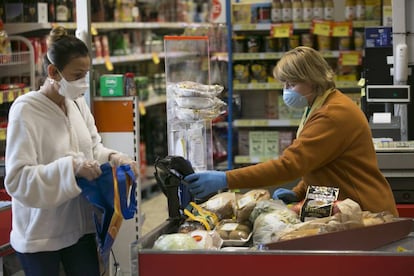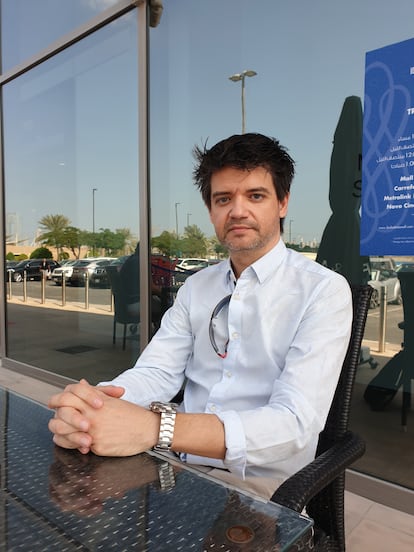Should the supermarket cashier get vaccinated first against the coronavirus?
A new study suggests giving people with the most social interactions, and not at-risk groups, priority access to immunizations

The first coronavirus vaccines are about to be authorized, and the next challenges will deal with distribution and deciding who gets early access to immunizations that will not be available to the entire population at first.
Several European governments, including the Spanish one, have already indicated that priority will be given to at-risk groups: older citizens and those with pre-existing conditions that make them especially vulnerable.
But a research project led by the Spaniard Jorge Rodríguez at Khalifa University in Abu Dhabi (United Arab Emirates) is questioning that criteria.
We are in uncharted waters, and as scientists, it is our duty to contribute whatever we can to ensure decisions are as informed and transparent as possibleJorge Rodríguez, chemical engineer
His model instead proposes targeting individuals with the most social interaction, such as essential workers and young people. This, he says, would multiply the vaccine’s effectiveness by reducing infections and fatalities among immunized individuals and those who are in contact with them.
“Our results run counter to the vaccination plans for the general population, and practically recommend the opposite age-based sequence than the one being proposed,” says Rodríguez, 43, speaking during an interview in Dubai.
“Our model indicates unequivocally that priority vaccination of groups with the most daily person-to-person interactions could substantially reduce total fatalities in a country like Spain, compared with criteria based on [population groups with] the highest mortality,” he adds.

A chemical engineer who is working on mathematical modeling of biological processes at Khalifa University, Rodríguez refuses to offer a comparison by numbers because he does not want to create alarm. But the charts included in his study, which still needs to undergo peer review and which was co-directed by the Colombian epidemiologist Juan M. Acuña and the Spanish engineer Mauricio Patón, talk about a difference of “tens of thousands” of cases, depending on several criteria such as the vaccine’s effectiveness, vaccination rates and use of protection measures.
The paper explaining the model, which uses data from Spain, estimates that proper prioritization could reduce fatalities by as much as 70%. “Strikingly, our results show in all cases, that prioritization of groups with the highest mortality but fewer social interactions, may lead to significantly larger numbers of final total fatalities, even higher as if [sic] no group priorities were established at all,” reads the study.
Rodríguez says he is aware that his conclusions do not support traditional lines of thought. “When I discussed it with other scientists, they told me that it runs counter to all the usual public health guidelines, but then again we have never had a situation with such a shortage of vaccines,” he notes.
To illustrate his point, he uses the example of a supermarket cashier. “If we have 10 vaccines and 30 people, half of whom are seniors, who do we immunize first?” he asks. “The 90-year-old man who spends most of his time at home and takes measures to protect himself? Or the 26-year-old woman who works as a cashier at the supermarket where the 90-year-old, my mother and other local residents go buy their groceries?”
Rodríguez adds that if an older person has a lot of social interaction, he or she should also be prioritized. The point, he says, is that interaction and not just age should be a factor in deciding who gets first access to the vaccines.
If you immunize the spreaders, you cut off transmission regardless of age and you end the exponential spread of the diseaseJorge Rodríguez, chemical engineer
“If you immunize the spreaders, you cut off transmission regardless of age and you end the exponential spread of the disease,” he adds, noting that his model applies to the general population and not to healthcare workers, although doing so would only reinforce his model, as these workers have many daily interactions.
Rodríguez admits that the results of the study were so surprising that the team reviewed all the data again. But they also found that in 2009, the journal Science published a study on flu in the United States that suggested a similar strategy: in scenarios of vaccine shortages, it might be more efficient to first immunize children and teenagers, who are the major spreaders, instead of seniors, who are the flu’s main victims. There is no similar existing study on Covid-19.
“We are in uncharted waters, and as scientists, it is our duty to contribute whatever we can to ensure decisions are as informed and transparent as possible,” he says. Rodríguez admits that he embarked on this project out of frustration at not understanding what criteria were being used to make decisions at the beginning of the pandemic. The researchers have used open-code programming and will make it available to anyone who wants it. For now, local authorities have asked them to apply the model to the Emirates using this country’s demographic data.
English version by Susana Urra.
Tu suscripción se está usando en otro dispositivo
¿Quieres añadir otro usuario a tu suscripción?
Si continúas leyendo en este dispositivo, no se podrá leer en el otro.
FlechaTu suscripción se está usando en otro dispositivo y solo puedes acceder a EL PAÍS desde un dispositivo a la vez.
Si quieres compartir tu cuenta, cambia tu suscripción a la modalidad Premium, así podrás añadir otro usuario. Cada uno accederá con su propia cuenta de email, lo que os permitirá personalizar vuestra experiencia en EL PAÍS.
¿Tienes una suscripción de empresa? Accede aquí para contratar más cuentas.
En el caso de no saber quién está usando tu cuenta, te recomendamos cambiar tu contraseña aquí.
Si decides continuar compartiendo tu cuenta, este mensaje se mostrará en tu dispositivo y en el de la otra persona que está usando tu cuenta de forma indefinida, afectando a tu experiencia de lectura. Puedes consultar aquí los términos y condiciones de la suscripción digital.
More information
Últimas noticias
Most viewed
- Reinhard Genzel, Nobel laureate in physics: ‘One-minute videos will never give you the truth’
- Oona Chaplin: ‘I told James Cameron that I was living in a treehouse and starting a permaculture project with a friend’
- Pablo Escobar’s hippos: A serious environmental problem, 40 years on
- Charles Dubouloz, mountaineering star, retires at 36 with a farewell tour inspired by Walter Bonatti
- Why we lost the habit of sleeping in two segments and how that changed our sense of time











































